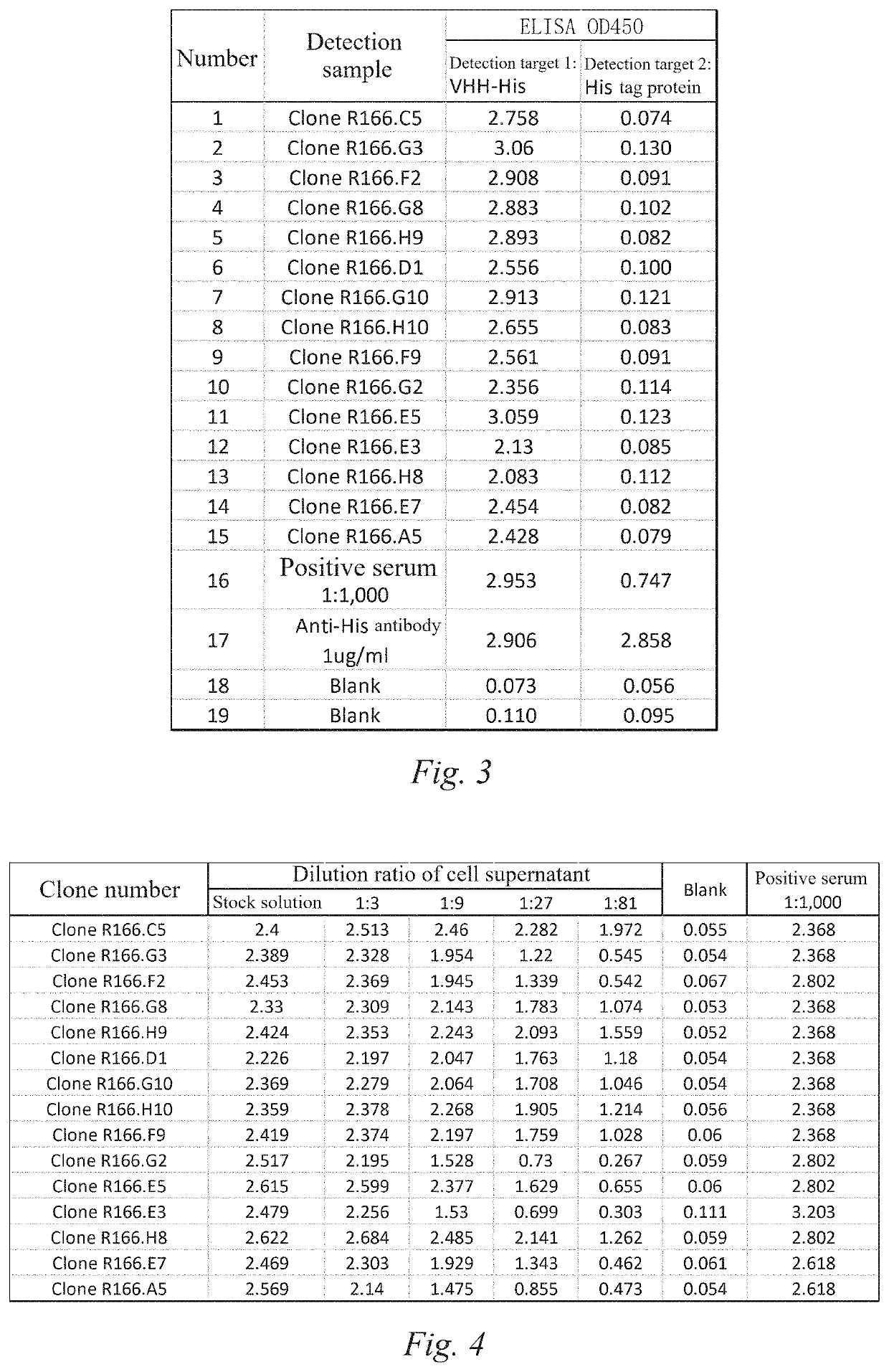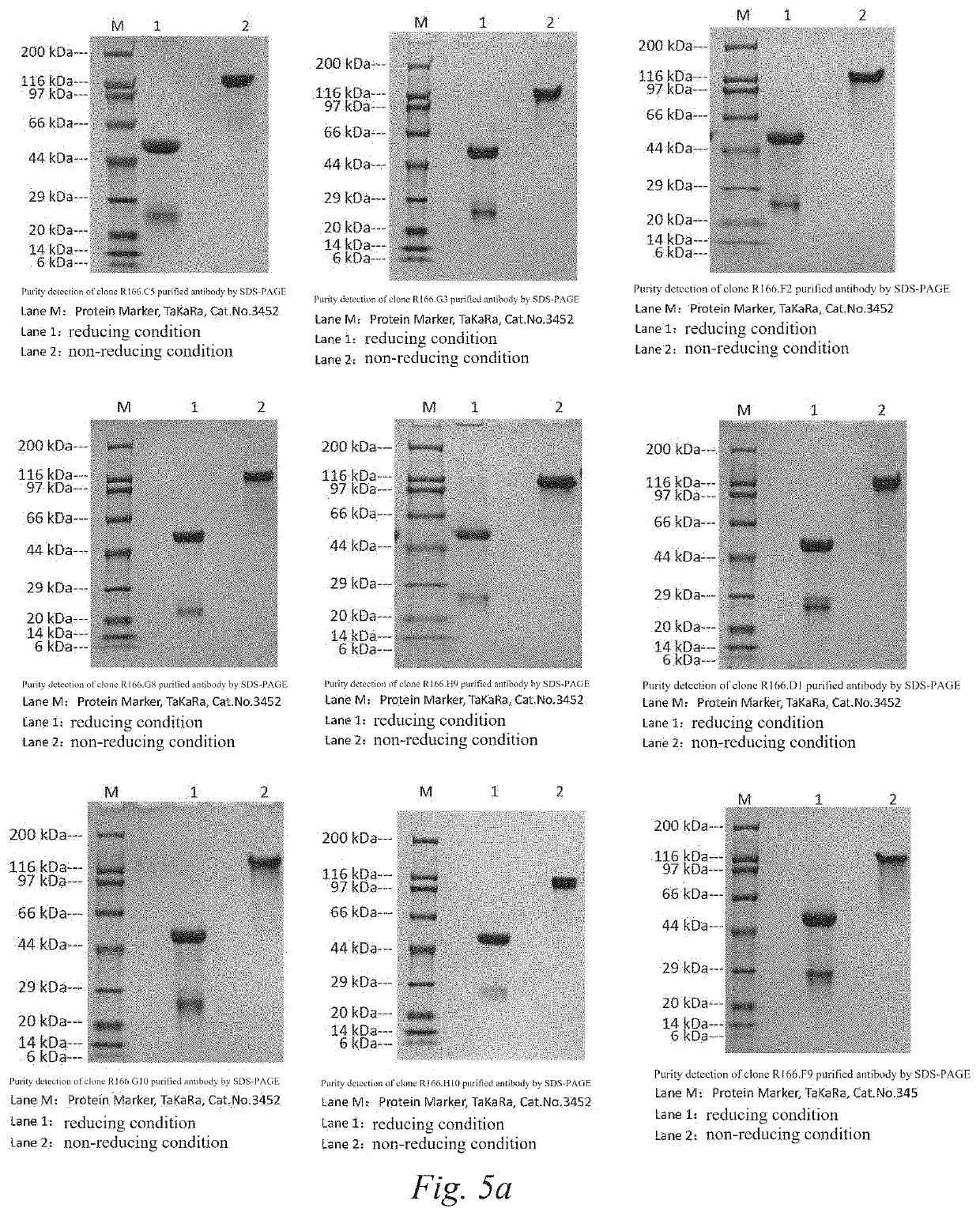Anti-VHH Domain Antibodies and Use Thereof
an antibody and domain technology, applied in the field of anti-vhh domain antibodies, can solve the problem of lack of an antibody for identifying camel-derived nanobodies
- Summary
- Abstract
- Description
- Claims
- Application Information
AI Technical Summary
Problems solved by technology
Method used
Image
Examples
example 1
on of Hybridoma Cell Strain of Antibody
[0151]1) Animal immunization. The recombinantly expressed His-tag camel-derived nanobody VHH-His (the amino acid sequence thereof is shown in FIG. 1 or SEQ ID NO: 241) was used as an antigen for animal immunization. The nanobody AS718 is an antigen used for animal immunization, has a C-terminal His tag and contains a total of 121 amino acids. The CDR domain and His tag are underlined in FIG. 1.
[0152]8 New Zealand rabbits were subcutaneously immunized with a 1:1 emulsion containing 200 μg of VHH-His and 200 μl of Freund's complete adjuvant (Sigma-Aldrich, CAT #: F5881); the 1:1 emulsion containing 200 μg of VHH-His and Freund's incomplete adjuvant (Sigma-Aldrich, CAT #: F5506) was subcutaneously injected 4 times every 2 weeks to boost immunity to New Zealand rabbits; 4 days before myeloma fusion, the serum antibody titer was detected by ELISA (as shown in FIG. 2), and the serum titer of animal was detected. The results showed that all test value...
example 2
g of Variable Region of Antibody and Antibody Recombinant Production
[0159]The total RNA was extracted from 3×106-5×106 hybridoma cells with TRIzol (Ambion, CAT #: 15596-026) and reverse transcribed into cDNA using an antibody subtype-specific primer and a universal primer (Takara PrimeScript™ 1st Strand cDNA Synthesis Kit, CAT #: 6110A). Subsequently, heavy chain and light chain variable region fragments of rabbit immunoglobulin were amplified by RACE PCR, and the resulting PCR fragments were subcloned into a pMD18-T vector system (Takara, CAT #: 6011); and a vector-specific primer was used to sequence the inserted fragments. Finally, nucleotide / protein sequences of heavy chain and light chain variable regions of 15 monoclonal antibodies were obtained, including clone R166.C5, clone R166.G3, clone R166.F2, clone R166.G8, clone R166.H9, clone R166.D1, clone R166.G10, clone R166.H10, clone R166.F9, clone R166.G2, clone R166.E5, clone R166.E3, clone R166.H8, clone R166.E7, and clone R1...
example 3
f Antibody to Recombinant Camel Nanobody
[0162]The binding ability of the purified antibodies of 15 camel-derived nanobodies to 10 different camel-derived nanobodies VHH (with the amino acid sequences shown in SEQ ID NO: 246-255, respectively) was evaluated by the indirect ELISA method.
[0163]The ELISA plate was coated with 10 different VHHs at 0.5 m / ml in 100 μl / well of PBS at 4° C. overnight, respectively; the plate was washed with PBS-T (0.05% Tween) and blocked with 200 μl / well of PBST containing 1% BSA at 37° C. for 0.5 hours; the blocking solution was aspirated and discarded, and 100 μl of 1 μg / ml purified antibodies were added to the first well, diluted in a 3-fold gradient for a total of 11 test concentration gradients and incubated at room temperature for 1 hour; the plate was washed three times with PBST and incubated with 100 μl / well of goat anti-rabbit IgG conjugated with horseradish peroxidase (GenScript Goat Anti-Rabbit IgG Antibody (H&L) [HRP], pAb; CAT #: A00098) at 37...
PUM
| Property | Measurement | Unit |
|---|---|---|
| Fraction | aaaaa | aaaaa |
| Fraction | aaaaa | aaaaa |
| Fraction | aaaaa | aaaaa |
Abstract
Description
Claims
Application Information
 Login to View More
Login to View More - R&D
- Intellectual Property
- Life Sciences
- Materials
- Tech Scout
- Unparalleled Data Quality
- Higher Quality Content
- 60% Fewer Hallucinations
Browse by: Latest US Patents, China's latest patents, Technical Efficacy Thesaurus, Application Domain, Technology Topic, Popular Technical Reports.
© 2025 PatSnap. All rights reserved.Legal|Privacy policy|Modern Slavery Act Transparency Statement|Sitemap|About US| Contact US: help@patsnap.com



